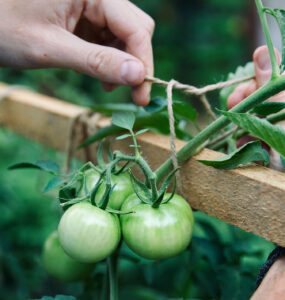
Cherry Maggots
by Rob Sproule
We’ve heard a lot about apple maggots lately and, unfortunately, the prognosis for backyard apple growers is pretty dire. For every fruit there is a pest, it seems, and for those who thought their sour cherry crop was immune to bugs, I introduce you to the Western Cherry fruit fly.
This pest has proven himself an all-around jerk in cherry orchards across the Western US and in BC. Able to wipe out whole crops of cherries by making them commercially unsalable, the fly, also known as “cherry maggot”, has been spreading north and east thanks to global warming. It attacks all varieties of cultivated and wild cherries, from the big BC sweet to the humble sour.
Like apple maggot, the bugs are more disgusting than dangerous. And like apple maggots, they are tough to control, overwinter under the host tree, and buzz about freely from tree to tree.
Life Cycle:
The hard shelled pupae, which look like a large grain of brown rice, overwinter in the soil. Temperature matters, and hard winters tend to keep the population in line. With hard winters being few and far between, we can expect to see much more of them.
The fly buzzes up once the ground has cooled starts its 2-3 week life cycle. They don’t do any damage to the tree until they lay their nasty little eggs into a puncture on emerging cherries. Egg leads to maggot, a creamy white, legless blob that chews its way towards the pit of the fruit, out of reach of any pesticides, and gorges there. 2-3 weeks after hatching they bore out of the cherries and drop to the ground.
The maggots burrow into the soil to pupate within a few hours of touching the ground, where they either wait until the next spring or, in some cases, the spring after that.
You’ll be able to spot an infected cherry only after the little bugger has dropped out by a telltale hole in the flesh. With 1 maggot spending weeks feasting, the inside of the cherry will be brown, rotten, and largely hollow.
Control:
Between being a hard shelled pupae and a maggot protected inside a cherry, you have a short window when they’re a fly when they’re vulnerable. For 2-3 weeks, typically when the cherries are still green, the small flies, with white and black banded wings, are buzzing in and around the tree. This is when the orchardists begin their regiment of spraying, but I don’t recommend pulling out the insecticides. You’ll wipe out the bees, pump toxins into the cherries, and undoubtedly miss enough flies that the problem won’t go away.
Prevention is key. A thick layer of mulch under the drip line of your tree will prevent the pupae from overwintering in the soil. You could also lay down a tarp (which will kill the grass over extended time) over a fine netting to catch the aphids.
Make sure to remove all fruit from infected trees at the end of the season, even if that means pruning back high branches so you can reach them.
If you only have 1 or 2 trees, you can wrap the tree in fine netting after pollination (when the flowers have died off). When the flies emerge they won’t be able to access the tree, and because they’re weak fliers they may not be able to get to the next tree.















